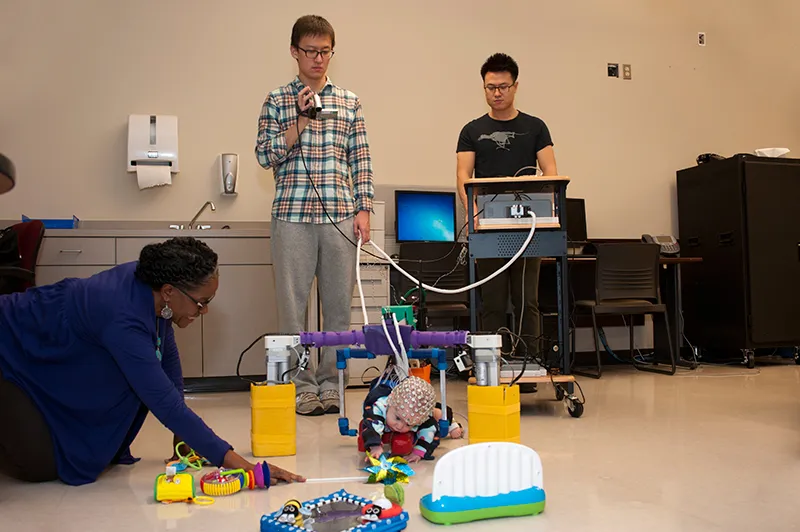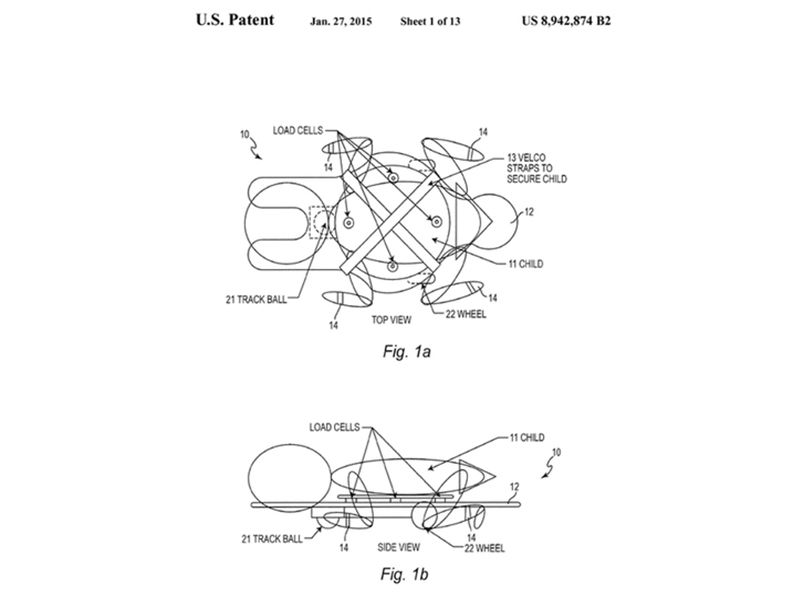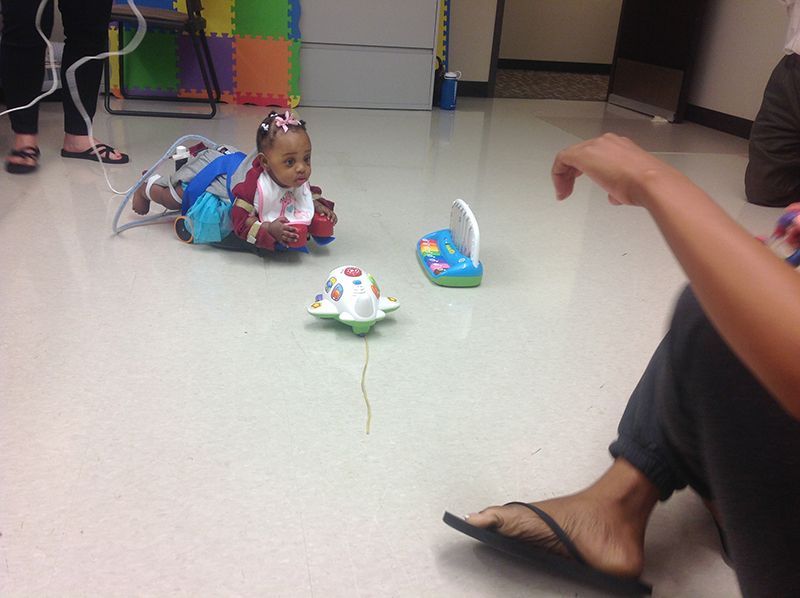This Skateboard-Like Device Helps At-Risk Infants Learn to Crawl
An innovative physical therapy device boosts babies’ movement efforts and helps their brains make critical connections
:focal(514x152:515x153)/https://tf-cmsv2-smithsonianmag-media.s3.amazonaws.com/filer/80/f4/80f44040-6d8d-4ddb-a00d-ca0ac7651507/peter-pidcoe.jpg)
Though most mothers of babies born extremely early know their children have an uphill climb, Monica Ellis knew from the start that one of her new twin girls faced a mountain.
Kara and Katie were micro preemies, born at only 25 weeks of gestation. After the earliest days of touch-and-go interventions, Katie improved steadily, but her sister did not. Kara was on and off of ventilators and had trouble eating. Later, when she finally came home, she started making odd movements, scissoring her fingers, and continuing to have difficulty feeding. Kara failed to thrive.
A nurse with two older kids at home, Ellis knew children reach milestones at different rates. But a gut feeling and incessant research told her something just wasn’t right with Kara. Her pediatrician agreed, and referred her to a physical therapist. At just a few months old, Kara was diagnosed with cerebral palsy.
Kara’s physical therapist, Robert Eskew, knew of a colleague who was conducting some unusual new research into early interventions for children with cerebral palsy and other motor development delays. He suggested they pay her a visit.
“I was that mom who was on the computer all the time reading stuff, because I was so concerned for Kara,” Ellis says.

Ellis took her daughter to Thubi Kolobe, a physical therapist at the University of Oklahoma Health Sciences Center, who studies and works with babies as they learn how to move. Earlier in her career at the University of Illinois at Chicago, Kolobe and colleagues developed an assessment, the Test of Infant Motor Performance, to identify infants most at risk of developing cerebral palsy (CP). That work morphed into an interest in how those brain development issues affect motor development in very young children.
Kolobe and Peter Pidcoe, a former Chicago colleague, have created a skateboard-like device, called the SIPPC (“sip-see”), or Self-Initiated Prone Progressive Crawler. The invention allows motor-challenged babies to learn to inch themselves around.
***
An estimated 80 to 90 percent of children with CP are born with the condition, and doctors are still working to understand its causes. A range of factors can lead to the brain damage that characterizes CP, including brain infections, head injuries or other early trauma. Extra-early babies like Kara and Katie are also a high-risk group. Regardless of the cause, CP always affects muscle control, and in children, it’s often not diagnosed until they are a year old or more.
The problem with that late diagnosis is that by the time parents and doctors notice a problem, the baby has already passed through the stages of learning how to move—rolling, sitting, crawling, cruising and toddling. The random kicks and wiggles of a normal 3-month baby are doing important work by forming crucial neural connections that lead to advanced motor skills, such as walking or writing with a pencil.
Putting a colorful toy just out of a baby’s reach is usually enough to stimulate him to reach for it, to attempt to lurch in its direction. He is rewarded when the effort results in movement toward the toy. Eventually, with more and more practice, baby learns to quickly move and grab the toy, because his developing brain reinforces the neural connections that control that skill.
But the reverse is also true. Infants’ brains have a ruthless “use it or lose it” policy. If a baby tries to move and doesn’t get the desired effect, the brain eventually prunes off that motor pathway. Babies with CP are often unsuccessful in their attempts.
Through her work with infants, Kolobe grew increasingly concerned that babies at risk for CP were losing out early unnecessarily. Movement therapy for young children with CP involves passive strategies, like putting them on a towel and gently pulling them around. But the children aren’t moving themselves, so those movement pathways still aren’t being reinforced. Kolobe felt technology had to offer a solution.
“I thought there must be a way to support these babies, to bypass those constraints on them and still enable them to drive themselves to move and explore,” Kolobe says. “I wanted something that could harness a baby’s early independent movements, to keep them going and convert them into functional use.”
***
In 2003, Kolobe turned to Pidcoe, who runs a peculiar laboratory at Richmond’s Virginia Commonwealth University. People come to him—a physical therapist and engineer—when they need help creating a therapy tool that doesn’t yet exist. Equal parts Doc Brown and dialed-down Tony Stark, Pidcoe tinkers away in a garage in the basement of VCU’s West Hospital. There, he makes devices from electronic fatigue monitors to predict potential ankle sprains to prosthetic limbs. His lab is full of wires, motors, computer chips and modified exercise equipment, like the elliptical machine that he and graduate students adapted for use as a gait trainer for stroke patients.
With input from Kolobe, Pidcoe wrote the algorithms and built a motorized device with sensors that respond to babies’ little kicks and weight shifts by rewarding them with an extra boost. A baby lies directly on the cushioned board, secured in place with soft Neoprene straps, and his arms and legs connect to sensors attached to the onboard computer. Later versions of the SIPPC had a “onesie mode,” a shirt with embedded sensors to fine-tune directional detection, so that even babies who couldn’t generate much force would be reinforced by forward, lateral or backward motion.
“There is sophisticated measurement of the movement of a child’s arms and legs, and the SIPPC uses that to identify patterns we want to reward,” Pidcoe explains. “You direct the reward to the activities you’re trying to achieve.”

Pidcoe and some of his students will be demonstrating the SIPPC at the Smithsonian’s Innovation Festival at the National Museum of American History on September 26 and 27. The event, organized by the Smithsonian Institution and the U.S. Patent and Trademark Office, will showcase new technologies developed by independent inventors and others from universities, companies and government agencies.
***
Ellis, who lives in Calumet, Oklahoma, was able to get Kara enrolled in a new study Kolobe was running to test the SIPPC’s effectiveness as a therapeutic device. Initially, Kara would just lay there on her belly, unmotivated to participate. She sucked her fingers and watched as her mother and Kolobe tried to entice her to play.
“To get her moving, we’d pop her fingers out of her mouth, and she’d get mad,” Ellis recalls. They could then get Kara’s attention with a toy. The first time she reached for an object on her own, Ellis and Kolobe cheered.
“It flipped a switch,” Ellis says. “She’d turn her head and look at us like ‘Oh, you like this?’ That positive response really helped her to learn to start doing things on her own.”
With help and reinforcement from the SIPPC, Kara learned how to crawl. Today, an active four-year-old in preschool with her sister, Kara walks and talks and runs. She has officially been discharged from physical therapy. Ellis says if it weren’t for the SIPPC, the small obstacles of Kara’s infancy would have been infinitely more challenging to overcome.
“Even as a little preemie, she let everyone do everything for her because she couldn’t do it by herself,” Ellis says. “The wait-and-see approach to cerebral palsy could be changed if everyone would try to think a little differently. With early intervention, we can get these babies to rewire their brains early.”
Kolobe, too, is driven to show that even very young infants are highly capable of making huge gains in the face of a potential disability.
“This is what can happen when we harness and multiply the little capabilities that they have so that they can be successful, and only technology can allow us to do that,” she says. “As a scientist, there are so many questions to be answered, and I feel we haven’t even scratched the surface with what we can learn from this.”

Kolobe and Pidcoe continue to work on the SIPPC in their respective labs, but in slightly different capacities. Kolobe is currently using a neural feedback net to investigate the real-time activity in babies’ brains as they navigate with the SIPPC, while Pidcoe is working to refine the design in the hopes that it will be commercially available to parents and therapists at a relatively affordable price.
The versions that will be on display at the Smithsonian’s Innovation Festival this weekend currently cost between $200 and $300 to produce. Ultimately, Pidcoe envisions versions that can be driven with a cell phone app, and even one for blind children that uses gentle haptic feedback buzzing to entice a child in the right direction.
“We want to look at how we can introduce technology to benefit children earlier,” Pidcoe says. “This is one example of how clinical and engineering tools are blending beautifully.”
The Smithsonian's Innovation Festival will be held at the National Museum of American History on September 26 and 27, between 10 a.m. and 5 p.m.
/https://tf-cmsv2-smithsonianmag-media.s3.amazonaws.com/accounts/headshot/Michelle-Donahue.jpg)


/https://tf-cmsv2-smithsonianmag-media.s3.amazonaws.com/accounts/headshot/Michelle-Donahue.jpg)